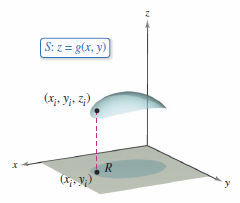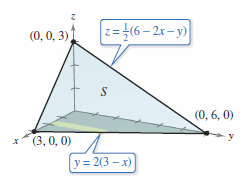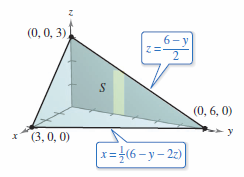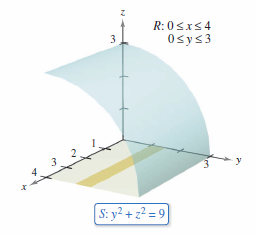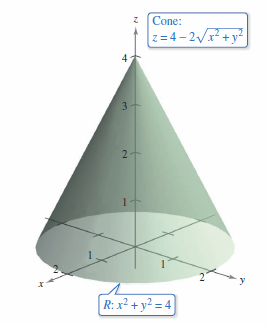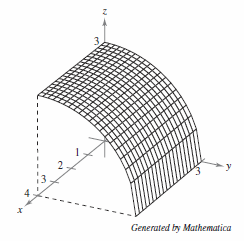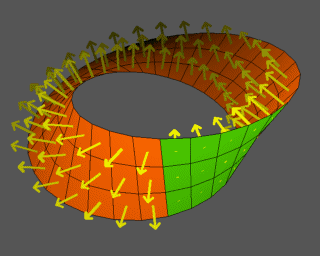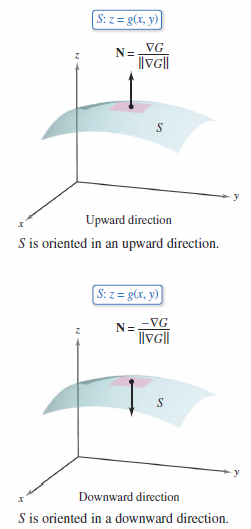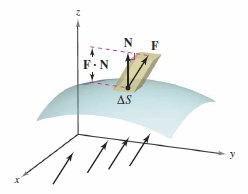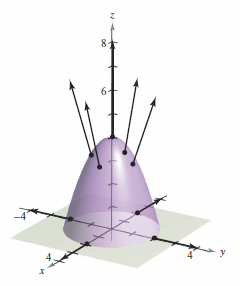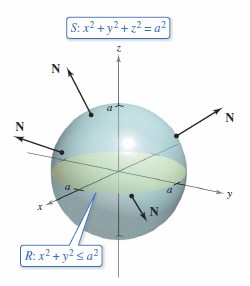Calculus III 15.06 Surface Integrals
| Previous | Calculus III 15.05 Parametric Surfaces |
| Next | Calculus III 15.07 Divergence Theorem |
Contents
15.6 Surface Integrals
- Evaluate a surface integral as a double integral.
- Evaluate a surface integral for a parametric surface.
- Determine the orientation for a surface.
- Understand a flux integral.
Surface Integrals
|
|
Surface integrals give by \(z=g(x,y)\) are discussed first with the parametric form discussed later on. Let \(S\) be a surface given by \(z=g(x,y)\) and let \(R\) be its projection onto the \(xy\)-plane, as shown in Figure 15.6.1. Let \(g\), \(g_{x}\), and \(g_{y}\) be continuous at all points in \(R\) and let \(f\) be a scalar function defined on \(S\). Recall from Section 14.5 the formula for surface area extends to three dimensions producing the sum
where
Provided the sum's limit as \(\| \Delta \| \) approaches zero exists, the surface integral for \(f\) over \(S\) is defined as
This integral can be evaluated by a double integral. |
Theorem 15.6.1 Evaluating a Surface Integral
Let \(S\) be a surface given by \(z=g(x,y)\) and let \(R\) be its projection onto the \(xy\)-plane. If \(g\), \(g_{x}\), and \(g_{y}\) are continuous on \(R\) and \(f\) is continuous on \(S\), then the surface integral for \(f\) over \(S\) is
- $$ \int_{S} \int f(x,y,z) \: dS = \int_{R} \int f(x,y,g(x,y)) \sqrt{1+[g_{x}(x,y)]^{2} +[g_{y}(x,y)]^{2}} \: d A.$$
For surfaces described by functions for \(x\) and \(z\), or \(y\) and \(z\). If \(S\) is the graph for \(y=g(x,z)\) and \(R\) is its projection onto the \(xz\)-plane, then
- $$ \int_{S} \int f(x,y,z) \: dS = \int_{R} \int f(x,g(x,z),z) \sqrt{1+[g_{x}(x,z)]^{2} +[g_{z}(x,z)]^{2}} \: d A.$$
If \(S\) is the graph for \(x=g(y,z)\) and \(R\) is its projection onto the \(yz\)-plane, then
- $$ \int_{S} \int f(x,y,z) \: dS = \int_{R} \int f(g(y,z),y,z) \sqrt{1+[g_{y}(y,z)]^{2} +[g_{z}(y,z)]^{2}} \: d A.$$
If \(f(x,y,z)=1\) the surface integral over \(S\) yields the surface area for \(S\). For example, let the surface \(S\) be the plane given by \(z=x\), where \(0 \leqslant x \leqslant 1\) and \(0 \leqslant y \leqslant 1\). The surface area for \(S\) is \(\sqrt{2}\) square units. Try verifying that
- $$ \int_{S} \int f(x,y,z) \: dS = \sqrt{2}.$$
Example 15.6.1 Evaluating a Flat Surface Integral
|
|
Evaluate the surface integral
where \(S\) is the first-octant portion for the plane
Solution Begin by writing \(S\) as
Using the partial derivatives \(g_{x}(x,y) = -1\) and \(g_{y}(x,y) = -\frac{1}{2}\) produces
Applying the graph in Figure 15.6.2 and Theorem 15.6.1 produces
|
|
|
If \(S\) is projected onto the \(yz\)-plane, as shown in Figure 15.6.3, produces \(x=\frac{1}{2}(6-y-2z)\), and
The surface integral is
The same principle applies to the \(xz\)-plane. |
Example 15.6.2 Evaluating a Cylindrical Surface Integral
|
|
Evaluate the surface integral
where \(S\) is the first-octant portion for the cylinder
between \(x=0\) and \(x=4\), as shown in Figure 15.6.4.
which produces
Theorem 15.6.1 does not apply directly because \(g_{y}\) is not continuous when \(y=3\). But it does apply for \(0\leqslant b < 3\) with the limit as \(b\) approaches 3, as follows.
|
The function \(f\) defined on the surface \(S\) is simply \(f(x,y,z)=1\), the surface integral yields the surface area for \(S\),
- $$\text{Surface Area }=\int_{S} \int 1 \:dS.$$
When \(S\) is a lamina with variable density and \(\rho(x,y,z)\) is the density at the point \((x,y,z)\), then the mass for the lamina given by
- $$\text{Lamina Mass }=\int_{S} \int \rho(x,y,z) \:dS.$$
Example 15.6.3 Finding the Mass for a Surface Lamina
|
|
A cone-shaped surface lamina \(S\) is given by
as shown in Figure 15.6.5. At each point on \(S\), the density is proportional to the distance between the point and the \(z\)-axis. Find the mass \(m\) for the lamina.
with a density for \(\rho(x,y,z)=k \sqrt{x^{2}+y^{2}}\). Applying a surface integral produces the mass as
|
Parametric Surfaces and Surface Integrals
For a surface \(S\) given by the vector-valued function
- \(\textbf{r}(u,v)=x(u,v)\textbf{i} +y(u,v)\textbf{j} +z(u,v)\textbf{k} \) Parametric surface
defined over a region \(D\) in the \(uv\)-plane. The surface integral for \(f(x,y,z)\) over \(S\) is given by
- $$ \int_{S} \int f(x,y,z) \: dS = \int_{D} \int f(x(u,v),y(u,v),z(u,v))\|\textbf{r}_{u} (u,v)\times \textbf{r}_{v}(u,v) \| \: dA.$$
Note the similarity to a line integral over a space curve \(C\).
|
Line integral |
Note that \(ds\) and \(dS\) can be expressed as
- \(ds=\|\textbf{r}^{\prime}(t) \| \: dt\) and \(dS=\|\textbf{r}_{u} (u,v)\times \textbf{r}_{v}(u,v) \| \: dA.\)
Example 15.6.4 Evaluating a Surface Integral
|
|
Example 15.6.2 demonstrated a surface integral evaluation
where \(S\) is the first-octant portion for the cylinder
between \(x=0\) and \(x=4\), as shown in Figure 15.6.6. Reevaluate this integral in parametric form.
where \(0 \leqslant x \leqslant 4 \) and \(0 \leqslant \theta \leqslant \pi/2\). Begin the evaluation by calculating
Substituting these into the surface integral produces
|
Surface Orientation
|
|
Unit normal vectors are used to induce an orientation to a surface \(S\) in space. A surface is orientable when a unit normal vector \(\textbf{N}\) can be defined at every non-boundary point for \(S\) in such a way that the normal vectors vary continuously over the surface \(S\). The surface \(S\) is called an oriented surface. An orientable surface \(S\) has two distinct sides where each side is described by one unit normal vector. For a closed surface, such as a sphere, it is customary to choose the unit normal vector \(\text{N}\) that points outward from the closed surface. Most common surfaces, such as spheres, paraboloids, ellipses, and planes, are orientable. A Möbius Strip[1] is not orientable because one surfaces points outwards in every direction, as shown in Figure 15.6.8. The gradient vector for an orientable surface provides a convenient way to find a unit normal vector. That is, for an orientable surface given by
let
The surface \(S\) can be oriented outward by making the unit normal vector positive, or inward by making it negative,
and
as shown in Figure 15.6.8. If the smooth orientable surface \(S\) is given in parametric form by
then the unit normal vectors are given by
and
Note that reversing the order for \(\textbf{r}_{u}\) and \(\textbf{r}_{v}\) changes the orientation. For an orientable surface given by
use the gradient vector
or
to orient the surface. |
Flux Integrals
|
|
An application for a surface integral in vector form is how a fluid flows through a surface. Consider an oriented surface \(S\) submerged in a fluid having a continuous velocity field \(\textbf{F}\). Let \(\Delta S \) be the area for a small patch on \(S\) over which \(\textbf{F}\) is nearly constant. Then the fluid volume crossing this region per time unit is approximated by the volume for the column with height \(\textbf{F} \cdot \textbf{N}\), as shown in Figure 15.6.9. As an equation,
Therefore the fluid volume crossing the surface \(S\) per time unit, called the flux of \(\textbf{F}\) across \(S\) is given by the surface integral in Definition 15.6.1. |
Definition 15.6.1 Flux Integral
Let \(\textbf{F}(x,y,z) = M\textbf{i} +N \textbf{j} +P \textbf{k}\), where \(M\), \(N\), and \(P\) have continuous first partial derivatives on the surface \(S\) oriented by a unit normal vector \(\textbf{N}\). The flux of \(\textbf{F}\) across \(S\) is given by
- $$ \int_{S} \int \textbf{F} \cdot \textbf{N} \: dS.$$
Geometrically, a flux integral is the surface integral over \(S\) for the normal component for \(\textbf{F}\). If \(\rho(x,y,z)\) is the fluid density at \((x,y,z)\), then the flux integral
- $$ \int_{S} \int \textbf{F} \cdot \textbf{N} \: dS$$
represents the mass for the fluid flowing across \(S\) per time unit.
To evaluate a flux integral for a surface given by \(z=g(x,y)\), let
- \(G(x,y,z) = z-g(x,y)\).
Then, \(\textbf{N} \: dS\) can be written as follows.
| \(\textbf{N} \: dS\) | $$=\frac{\nabla G(x,y,z)}{\| \nabla G(x,y,z) \|} \:d S $$ |
| $$= \frac{\nabla G(x,y,z)}{\sqrt{(g_{x})^{2}+(g_{y})^{2} +1}} \sqrt{(g_{x})^{2}+(g_{y})^{2} +1} \: dA $$ | |
| \(= \nabla G(x,y,z) \: dA \) |
For an oriented surface \(S\) given by the vector-valued function
- \(\textbf{r}(u,v) = x(u,v)\textbf{i} +y(u,v) \textbf{j} +z(u,v)\textbf{k} \:\:\:\: \color{red}{ \text{Parametric surface }} \)
defined over a region \(D\) in the \(uv\)-plane the flux integral for \(\textbf{F}\) across \(S\) as
| $$\int_{S} \int \textbf{F} \cdot \textbf{N} \: dS$$ | $$= \int_{D} \int \textbf{F} \cdot \left( \frac{\textbf{r}_{u} \times \textbf{r}_{v}}{\| \textbf{r}_{u} \times \textbf{r}_{v} \|} \right) \|\textbf{r}_{u} \times \textbf{r}_{v} \| \: dS $$ |
| $$= \int_{D} \int \textbf{F} \cdot (\textbf{r}_{u} \times \textbf{r}_{v}) \: dA$$ |
Note the similarity between this integral and the line integral
- $$ \int_{C} \textbf{F} \cdot \: d\textbf{r} = \int_{C} \textbf{F} \cdot \textbf{T} \: ds$$
A summary for the line and surface integrals discussed so far are presented in Summary 15.6.1.
Theorem 15.6.2 Evaluating a Flux Integral
Let \(S\) be an oriented surface given by \(z=g(x,y)\) and let \(R\) be its projection onto the \(xy\)-plane.
- $$ \int_{S} \int \textbf{F} \cdot \textbf{N} \: dS = \int_{R} \int \textbf{N} \cdot [-g_{x}(x,y) \textbf{i} -g_{y}(x,y) \textbf{j} + \textbf{k} ] \: dA \:\:\:\: \color{red}{ \text{Oriented upward }}$$
- $$ \int_{S} \int \textbf{F} \cdot \textbf{N} \: dS = \int_{R} \int \textbf{N} \cdot [g_{x}(x,y) \textbf{i} +g_{y}(x,y) \textbf{j} - \textbf{k} ] \: dA \:\:\:\: \color{red}{ \text{Oriented downward }}$$
For the first integral, the surface is oriented upward, and for the second integral, the surface is oriented downward.
Example 15.6.5 Using a Flux Integral to Find the Mass Flow Rate
|
|
Let \(S\) be the a patch on the paraboloid
lying above the \(xy\)-plane, oriented by an upward unit normal vector, as shown in Figure 15.6.10. A fluid with consistent density \(\rho\) is flowing through the surface \(S\) according to the vector field
Find the mass flow rate through \(S\). The mass flow rate through the surface \(S\) is
|
Example 15.6.6 Finding the Flux for an Inverse Square Field
|
|
Find the flux over the sphere \(S\) given by
where \( \textbf{F}\) is an inverse square field given by
and
Assume \(S\) is oriented outward, as shown in Figure 15.6.11.
where \(0 \leqslant u \leqslant \pi\) and \(0 \leqslant v \leqslant 2 \pi\). The partial derivatives for \(\textbf{r}\) are
and
which implies the normal vector \(\textbf{r}_{u} \times \textbf{r}_{v}\) is
Back substitution produces
Multiply the flux integral by the partial derivative product produces
Applying Theorem 15.6.2 produces the flux over the sphere \(S\)
|
Example 15.6.6 shows that the flux across a sphere \(S\) in an inverse square field is independent from \(S\)'s radius. Note that if \(\textbf{E}\) is an electric field, then the result, along with Coulomb's Law[2], yields Gauss's Law[3] from electrostatics:
- $$ \int_{S} \int \textbf{E} \cdot \textbf{N} \: dS = 4 \pi k q \:\:\:\: \color{red}{ \text{Gauss's Law}}$$
where \(q\) is a point charge located at the sphere's center and \(k\) is the Coulomb Constant. Gauss's Law is valid for more general closed surfaces that enclose the origin, and relates the flux from the surface to the total charge \(q\) inside the surface.
Surface integrals are also used to study heat flow. Heat flows from higher temperature area to lower temperature areas in the direction where change is greatest. Therefore, a temperature gradient is used to measure heat flux. The flux depends on the surface area. Heat flowing along the normal direction, normal vector, losses heat, whereas heat flowing in directions tangential to the surface lose no heat. For example, assume the heat flux across surface area portion \(\Delta S \)is given by \(\Delta H \approx -k \nabla T \cdot \textbf{N} \: dS\), where \(T\) is the temperature. The variable \(\textbf{N} \) is the unit normal vector to the surface in the heat flow's direction, and \(k\) is the material's thermal diffusivity. The heat flux across the surface is given by the equation
- $$H= \int_{S} \int -k \nabla T \cdot \textbf{N} \: dS.$$
Summary 15.6.1 Line and Surface Integrals
Line Integrals
| \( ds \) | \(= \| \textbf{r}^{ \prime }(t) \| \: dt \) |
| \(=\sqrt{[x^{\prime}(t)]^{2}+[y^{\prime}(t)]^{2}+[z^{\prime}(t)]^{2}} \:dt \) |
- $$\int_{C} f(x,y,z) \:ds = \int_{a}^{b} f(x(t),y(t),z(t)) \: ds \:\:\:\: \color{red}{ \text{Scalar form}}$$
| $$\int_{C} \textbf{F} \cdot \:d\textbf{r}$$ | $$=\int_{C} \textbf{F} \cdot \textbf{T} \:ds $$ |
| $$=\int_{a}^{b} \textbf{F}(x(t),y(t),z(t)) \cdot \textbf{r}^{\prime}(t) \: dt \:\:\:\: \color{red}{ \text{Vector form}}$$ |
Surface Integrals \([z=g(x,y)]
- \( dS= \sqrt{1+[g_{x}(x,y)]^{2} +[g_{y}(x,y)]^{2}} \: d A\)
- $$\int_{S} \int f(x,y,z) \:dS = \int_{S} \int f(x,y,g(x,y))\sqrt{1+[g_{x}(x,y)]^{2} +[g_{y}(x,y)]^{2}} \: dA \:\:\:\: \color{red}{ \text{Scalar form}}$$
- $$ \int_{S} \int \textbf{F} \cdot \textbf{N} \: dS = \int_{R} \int \textbf{F} \cdot [-g_{x}(x,y)\textbf{i} -g_{y}(x,y) \textbf{j} + \textbf{k}] \: dA \:\:\:\: \color{red}{ \text{Vector form (upward normal)}}$$
Surface Integrals (parametric form)
- \( dS= \| \textbf{r}_{u}(u,v) \times \textbf{r}_{v}(u,v) \| \: d A\)
- $$\int_{S} \int f(x,y,z) \:dS = \int_{D} \int f(x(u,v),y(u,v),z(u,v)) \: dS \:\:\:\: \color{red}{ \text{Scalar form}}$$
- $$ \int_{S} \int \textbf{F} \cdot \textbf{N} \: dS = \int_{D} \int \textbf{F} \cdot (\textbf{r}_{u} \times \textbf{r}_{v}) \: dA \:\:\:\: \color{red}{ \text{Vector form}}$$
Internal Links
Parent Article: Calculus III 15 Vector Analysis
